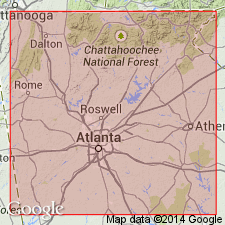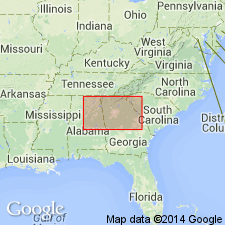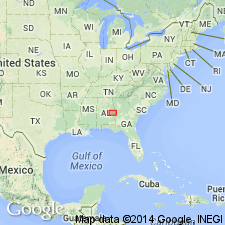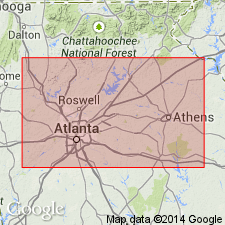
- Usage in publication:
-
- Factory Shoals Formation*
- Modifications:
-
- Named
- Dominant lithology:
-
- Schist
- Quartzite
- Graywacke
- AAPG geologic province:
-
- Piedmont-Blue Ridge province
Summary:
Named for exposures along Sweetwater Creek at Factory Shoals, GA. Includes rocks mapped by Higgins (1968) as aluminous schist. Consists of light-gray lustrous garnet-biotite-oligoclase-muscovite-quartz schist locally containing kyanite or staurolite. Contains layers of quartz-muscovite schist, thinly bedded red micaceous quartzite, muscovite-biotite-plagioclase metagraywacke, and graphitic-muscovite quartz schist. Locally metagraywacke predominates. In gradational contact with Chattahoochee Palisades Quartzite at its base, and grades over a short distance into the Rottenwood Creek Quartzite at its top. On the basis of mapping, is 1,000 to 2,000 m (3,290-6,570 ft) thick. Age is probably late Precambrian and (or) early Paleozoic.
Source: GNU records (USGS DDS-6; Reston GNULEX).

- Usage in publication:
-
- Factory Shoals Formation*
- Modifications:
-
- Revised
- Age modified
- AAPG geologic province:
-
- Piedmont-Blue Ridge province
Summary:
Rocks mapped by Hatcher (1971) as Tallulah Falls Formation are here shown to be part of the Factory Shoals Formation of the Sandy Springs Group in the Sandy Springs thrust sheet in GA and AL. The Tallulah Falls Formation is restricted from this area. Age is Late Proterozoic to Early Ordovician(?).
Source: GNU records (USGS DDS-6; Reston GNULEX).

- Usage in publication:
-
- Factory Shoals Formation
- Modifications:
-
- Revised
- AAPG geologic province:
-
- Piedmont-Blue Ridge province
Summary:
Lithologic units that compose the Jacksons Gap Group do not disappear beneath the Coastal Plain as previously thought, but can be mapped eastward around the hinge zone of the Tallassee synform where along the eastern limb they become the Loachapoka Schist of the Opelika Complex. The Loachapoka continues along the east limb of the synform into GA where it corresponds to the Sandy Springs thrust sheet of Higgins and others (1988). The Saugahatchee quartzite of the Loachapoka Schist, the Tallassee and Devils Backbone quartzites of the Jacksons Gap Group, and the Chattahoochee Palisades Quartzite are correlative. Authors suggest that the name Chattahoochee Palisades Quartzite be applied to these quartzites and further recommend that the schists of the Loachapoka and Jacksons Gap Group be referred to as the Factory Shoals Formation of the Sandy Springs Group.
Source: GNU records (USGS DDS-6; Reston GNULEX).

- Usage in publication:
-
- Factory Shoals Formation†
- Modifications:
-
- Abandoned
- AAPG geologic province:
-
- Piedmont-Blue Ridge province
Summary:
Remapping of Sandy Springs Group in its type area during 1990-1993 indicates that it is a sequence of fault slices that mimics true stratigraphy. Factory Shoals Formation cannot be mapped away from its type locality or section and is instead inseparable from rocks of aluminous schist unit of Sandy Springs Group. Rocks in gorge of Sweetwater Creek are deceptive because they are exceptionally fresh and therefore have a different appearance from slightly weathered "fresh" rocks away from gorge. Factory Shoals Formation is therefore abandoned and its rocks reassigned to informal aluminous schist unit of Sandy Springs Group. Report includes geologic map and correlation chart.
Source: GNU records (USGS DDS-6; Reston GNULEX).
For more information, please contact Nancy Stamm, Geologic Names Committee Secretary.
Asterisk (*) indicates published by U.S. Geological Survey authors.
"No current usage" (†) implies that a name has been abandoned or has fallen into disuse. Former usage and, if known, replacement name given in parentheses ( ).
Slash (/) indicates name conflicts with nomenclatural guidelines (CSN, 1933; ACSN, 1961, 1970; NACSN, 1983, 2005, 2021). May be explained within brackets ([ ]).

